Angmoh the BEST! Landing gear problem still landed safely. Fucking chinks would have bailed out.
Rubbish! Totally the opposite!
The video showed that the plane actually can land, all the COWARD PANIC ARE UNNECESSARY! Chow Ang Moh Cowards dumped missiles and will endanger marine safety fishermen and fishing boats. Lost $4.5 millions & the extra emergency costs!
PLA have dozens pilot saved aircrafts and peasants lives taking own live risk, I recall about 8 killed themselves by missing chance to eject or gave their own lives by decided not to eject in order to remain in control of aircraft to steer furthest away from populated areas, when malfunctions happened.
PLA awarded them martyrs, massive number of peasants sent off his funeral to appreciate his scarify saving their lives.
In this world no air force pilots are so brave and willing to die for service like PLA. The country and govt give highest honor and benefit to families of martyrs, nothing in any country can compare.
https://jnews.xhby.net/waparticles/234/u0G8eDnh8Nbug3JE/1
烈士放弃跳伞牺牲不应苛责,飞行员比我们更清楚该怎么选
2017-11-22 18:20 交汇点
本月7日,我军西部战区空军某部湖南澧县籍飞行员、飞行中队长黄鹏在飞行训练中突遭飞机事故。黄鹏为挽救战机,舍弃最佳逃生机会,最终英勇牺牲,年仅30岁。这起事故发生后,人们在为英雄惋惜的同时,又提起了两个老话题:遇到事故究竟应当保飞机还是坚决跳伞保飞行员,以及飞行员和飞机究竟谁更珍贵。
(黄鹏驾驶的是歼-11B战斗机)
毫无疑问,现代战斗机的价格和运行成本是极其昂贵的。比如我军培养飞行员常用的K-8教练机,每架约2000多万元人民币,全寿命约8000-10000飞行小时。这样,仅计算油钱和飞机折旧费用,每小时飞行成本就超过1万元。据媒体报道指出,我国空军使用歼教-7培训100名学员花费约24.5亿元,这样看培训一名学员平均就要花费2500万元左右。
(K-8教练机)
美国方面,F-22“猛禽”的每飞行小时成本大概在3万多美元。同为四代机,港媒《大公报》称歼-20战斗机每小时飞行成本是30万元人民币。这个数据不知有何权威根据,但应该只高不低,而且应当要高不少才对。
(F-22在机棚中,此类四代机的运行成本极高,但仍不如飞行员宝贵)
此处有个参照。俄罗斯方面公布的我军采购苏-35战斗机价格大约是8000万美元一架,即5亿元人民币左右,这还仅仅是机体本身的价格。算上机载设备、配套弹药等等,通常至少价格要翻一倍。按照机体寿命2000-4000小时计算(不算中期延寿),加上昂贵的航空燃油费用(加满至少10吨以上,价格超过10万元人民币),这样平摊算下来,每小时成本就已经接近《大公报》所说的30万元人民币了。如果算上各种训练正常消耗及地勤配套,苏-35这种3.5代机的飞行成本恐怕还要再增加。那么显然,需要专门机棚的四代机,运行成本只会更加高昂。
(目前已有多架苏-35加入我国空军)
但相对于飞行员的身价,飞机价值又不见得昂贵了。对培养一名飞行员的代价,有个通常的说法是和体重等重的黄金差不多。这种说法真实性如何呢?就以我军为例,在遴选之初,国家就要花费大量的选拔成本,招飞可以说是“千里挑一”。成为一名飞行学员也只是起步,要成为黄鹏这样牺牲前能够担负作战值班任务的飞行员,要经过“三级五阶段”的培训。所谓“三级”,是院校训练、基地训练、部队训练,“五阶段”则是基础训练、初教机训练、高教机训练、改装训练、战术训练。上述所有培训,从“飞行苗子”到一个仅仅是能飞三代机的“菜鸟”就得5年,其中花费的经费就已经十分惊人。按我国空军1986年统计数据,培养一名能够担负作战值班任务的歼-8飞行员就需要287万元人民币,轰-6飞行员需要465万元人民币,折合黄金分别是57公斤和93公斤,与飞行员体重基本相等。
这还仅仅是二代机。全世界普遍认为,一个成熟的三代机飞行员必须要具备相关的机型1000小时的飞行经验。黄鹏作为飞三代机的飞行中队长,飞行小时数肯定不低,练出来的成本超过飞行员体重等重黄金肯定不为过。
(歼-15战斗机带火迫降)
新的数据显示,飞行员“身价”用黄金来比已经是昨日黄花。空军招飞局南京选拔中心主任马东曾向媒体表示,一名合格的战斗机飞行员必须达到800个小时的飞行训练时间,每小时的成本是40万元。加上其它花费,培养一名战斗机飞行员至少需要3.4亿元。而在近期歼-15舰载战斗机空中撞鸟,飞行员曹先建沉着驾机带火着陆的新闻报道中,可以得知产量不高的歼-15大约是4亿元人民币一架。考虑到目前该型战机的飞行员都是从“老鸟”飞行员中“掐尖”选拔(至少飞过5个机种、飞行时间超过1000小时、三代战机飞行时间超过500小时),一旦牺牲其“沉没成本”将大幅超过“飞鲨”战斗机的价值。比如张超烈士的牺牲,其损失就难以估量。
(张超烈士在歼-15上)
但是我们注意到,像黄鹏这样竭尽全力挽救战机的例子仍然层出不穷,应当如何理解这种现象呢?
对试飞机、原型机来说,飞行员舍命带回的飞机,肯定有其不可估量的价值。对此,我军著名试飞员李中华曾经在央视表示,很多时候摔一架飞机并不仅仅是金钱问题。这是非常有道理的,因为引发战机故障的问题可能存在于所有同型战机或同系列其他改进型战机上,我们看到,一些军用飞机事故发生后,常常军方采取的举动是停飞所有同型号战机,直到排除隐患为止,有时这一停就是几个月。保住战机发现隐患,有可能就是拯救飞同型战机战友。
(李中华说,不到山穷水尽仍要尽力挽救战机)
从试飞这一工作的目的来看,如果发生故障就跳伞,那么很多故障原因在飞机残骸上是难以探究的,即使飞机上有“黑匣子”,也可能存在数据损坏、记录数据不全的问题,更何况飞行员的主观感觉是任何传感器都无法比拟的。
抛掉原型机等特殊机型,对量产机来说,肯定是飞行员比飞机的价值要高,这没有任何疑问。对地面指挥员来说,也不可能不清楚飞行员的培养成本与飞机价值孰轻孰重。在曹先建的新闻报道中,地面指挥员接受采访时说,如果发现飞机不可控,那就肯定命令他离机。这显示地面并没有要求飞行员一定要舍命保住战机的命令。
对飞行员来说,全力挽救战机并最终带回战机,或者在无法挽救的情况下使其受控坠毁避免伤及地面人员,是职业的本能反应。一种说法认为,一个遇事就直接跳伞的飞行员不能成长为一名优秀的飞行员,他的职业自尊也不允许他一遇到问题马上抛弃飞机——这与一般人认为的“人的生命高于一切”当然有矛盾。现代战机事故发生过程快、迫降难度大、技术要求高,对大众来说,应当明白飞行员作为受到长期培养的专业人员,作出的抉择肯定比坐在安全的地面上复盘要科学,应当尊重他们的选择。
(飞机弹射试验,实际飞行中这样好的弹射条件并不多)
同时也必须明确:飞行员牺牲这样的“学费”是必须要交的,虽然有时实在太昂贵了些。我国已经因为后发优势,避免了很多事故,但仍有大量障碍必须靠人“暴力”排除。这个过程,很可能伴随有牺牲。例如像舰载机领域,最为关键的涉及飞机姿态控制的飞控系统故障,因为是软件硬件结合的系统,是否有BUG并不是坐在机房里调试就能发现的,必须也只能靠实际运行。
(美军“福莱斯特”号航母舰载机事故照片)
我军已经有2000多位飞行员牺牲,而可以预料的是,这条路上将会有更多的牺牲出现,这是不可避免的。以舰载机领域绝对老大美国海军来说,2008年就因事故损失飞机16架、35人死亡。在喷气式舰载机刚刚投入军队应用的1950年代,美海军舰载机事故数量更是高得离谱:1953年,发生A级飞行事故2266起、损失飞机超700架、损失优秀飞行员423名;1954年,损失776架飞机、535名舰载机飞行员。这个规模放到现在,相当于每年美国现役舰载机轮番摔过一回。而就在笔者写下这段文字时,美国“里根”号航母舰载机联队一架C-2“灰狗”运输机失踪,为这个例子增添了最新的血色注脚。
(试飞员徐勇凌本人就摔过两次机)
要支撑起大国空中力量,道路就是如此充满荆棘和危险。2005年,一名美国退役飞行员在其书中指出,美国空军每10天就要摔一架飞机。在张超牺牲的去年4月,我国其他部队也有飞行事故发生。歼-10首席试飞员徐勇凌在张超烈士牺牲的消息披露后指出:“飞行风险是飞行的一部分,其规律可以被认识、被掌握,我们可以用良好的训练和科学的风险管理,逐渐降低飞行事故率,但绝对的“零事故”是难以做到的。事故并不可怕,重要的是我们能从事故的技术解读中,找出规律性的东西和经验。”
编辑: 陈月飞
http://bbs.tiexue.net/post_4262224_1.html
 铁血军事
铁血军事 >
铁血军事论坛 >
空军论坛 >
飞行员为免飞机坠落济南市区推迟跳伞英勇牺牲(滚动更新中!)
飞行员为免飞机坠落济南市区推迟跳伞英勇牺牲(滚动更新中!)
2033356 2010/5/20 14:55:46
480 71164
导读:5月6日晚,济南空军某师一架飞机在连续起飞过程中发动机突然停车,有坠落在济南市区的危险。为避免造成重大事故,两名飞行员尽力改变飞行轨迹,其中飞行员冯思广因错过最佳跳伞时机牺牲!
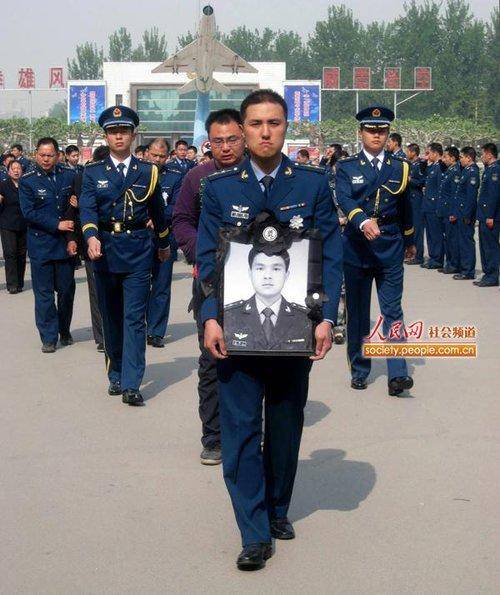
战友们送英雄冯思广最后一程~~~


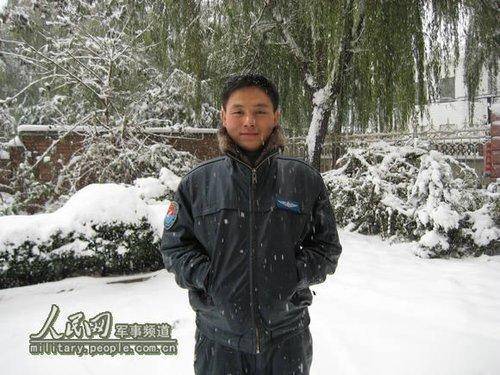








这几张是
空军飞行员冯思广烈士生前照片,看多么阳光帅气的济空飞行员冯思广
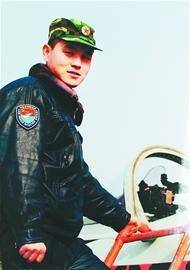
冯思广在飞行学院学习时的照片
五载峥嵘岁月为国奉献,二十八年风华正茂为民献身。
连日来,泉城济南处处传颂着济空飞行员冯思广舍身捍卫人民群众生命和财产安全的英雄事迹:5月6日晚,冯思广和中队长张
德山驾机在连续起飞过程中发动机骤然停车,为避免飞机坠落在济南人口稠密地区,冯思广把个人生死置之度外,和张
德山一起果断改变飞行轨迹,自己却因错过跳伞最佳时机英勇牺牲。“他用28岁的宝贵生命,书写了一曲忠诚于党、热爱人民的时代颂歌!”冯思广所在济空
航空兵某师
师长詹仁明介绍,5月6日,该师在济南组织跨昼夜飞行。20时51分,飞行员冯思广和张
德山驾机起飞。21时30分,第二次着陆连续起飞高度约50米,发动机声音骤然减小,推力迅速下降,后舱飞行员张德山急促向地面报告“我停车了”,飞行指挥员、师
参谋长沈树范迅即果断发出指令:跳伞!跳伞!
千钧一发之际,冯思广和张德山十分清楚:飞机前下方不远处,就是一大片居民区和夜市。如果不改变飞行轨迹,后果不堪设想!
生死关头,冯思广和张德山只有一个念头:最大限度地保障人民群众的生命和财产安全。他们没有立即弃机跳伞,不约而同地前推驾驶杆,将飞机由仰角12.3度迅速推至俯角9.8度,看到飞行轨迹已经避开居民区,才实施了跳伞。飞参记录显示,飞行员跳伞前,驾驶杆前推44毫米,由此改变了飞行轨迹。
按照飞机坐椅弹射程序,后舱先于前舱弹射,间隔为1.1秒。就在这1.1秒之间,先行跳出的后舱飞行员张德山跳伞成功。而前舱飞行员跳伞时飞机高度仅有32米,且带有16度俯角,低于弹射安全包线高度,弹射后降落伞未张开即坠地,前舱飞行员冯思广壮烈牺牲。
机组一次生死抉择的“推杆”,改变了飞机的飞行轨迹,改变了一名年轻飞行员的生命航向,保护了人民群众的生命和财产安全。据调查,飞机坠落地点与居民区直线距离为230米,附近有村庄、宾馆、工厂、市场、物流站,常住人口约4000人。如果不是两名飞行员临危不惧的正确处置,将会给省城带来不可估量的重大损失。“在生死关头最大限度地保护国家和人民群众生命财产安全,是人民空军每一名飞行员浸透到骨子里的信念!”济空
航空兵某师政治部主任姜录臣介绍,他们以空军
部队近年来涌现出的“蓝天英雄”梁万俊、李中华、
李剑英、李峰和孟凡升等先进事迹为生动教材,不断深化飞行人员的当代革命
军人核心价值观教育,使飞行员在处置重大空中特情时真正做到上不愧天、下不愧地、内不愧心,视人民群众利益高于一切、重于一切。 5月7日被批准为
革命烈士的冯思广,1982年1月出生于山东省聊城市茌平县肖家庄乡冯营村,2001年9月考入山东理工大学生物工程专业,2005年6月招飞入伍,2007年6月毕业于空军第三飞行学院,2009年荣立三等功,是一名爱家乡、爱亲人、爱战友、爱人民、爱社会的新一代优秀飞行员。
中央军委领导获悉后深情称赞:“虽然冯思广同志牺牲了,但那种视死如归、英勇无畏、对人民大忠大爱的精神永远值得我们学习!”冯思广烈士的英雄事迹在空军
部队引起深刻反响,成为广大官兵深化当代革命
军人核心价值观教育的生动教材。空军飞行员们表示,要像冯思广那样热爱祖国、热爱人民,为构建和谐社会倾心竭力。(来源:济南日报 505096转载)
值得尊敬的好飞行员,永远记住他的名字吧:冯思广!
这是英雄的妻子军医田文君,我们向她至敬:

冯思广和空军某场站医师田文君已于2009年8月领取了结婚证,几次计划举行婚礼,都因冯思广加紧进行改装训练而未能如愿。在5月10日上午的追悼会上,田文君以她和冯思广的名义,分别给济空
司令员刘忠
兴中将敬了两个
军礼,颤抖的右手久久没有放下。田文君说,“请
司令员见证,今天就是我和思广的婚礼……这辈子,嫁给这样的飞行员不后悔……我一定替思广为父母尽孝,让他在天堂无牵挂……”
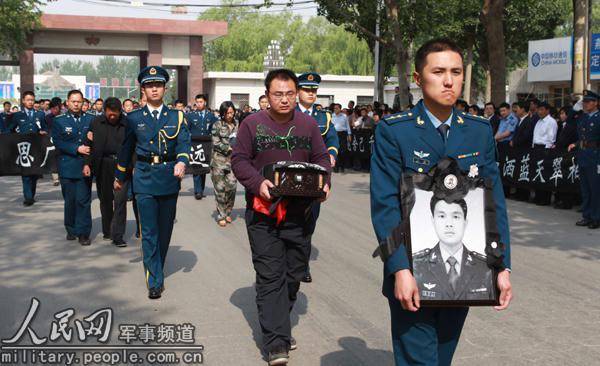
冯思广烈士“走”出他熟悉的营门。(图片转自:人民网 文章来源:济南日报
铁血军号505096转载)
妻子追悼会上补办婚礼:

5月12日,山东省茌平县烈士陵园里哀乐低回。主干道苍松翠柏间悬挂着黑底白字的横幅“沉痛悼念冯思广烈士”。

冯思广家境清贫,他和姐姐是靠7万元助学贷款完成了大学学业,招飞入伍后,冯思广省吃俭用去年才还完贷款。回想懂事孝顺的儿子,冯思广年迈的双亲很难站立起来,在官兵的搀扶下不停地抽泣着,哀痛欲绝。

冯思广烈士的父亲惜别爱子

家乡父老乡亲迎接英烈重归故里(图 崔文斌 摄)
英雄的生死抉择:冯思广牺牲前与地面对话曝光:
2010年5月6日晚,飞行员冯思广、张德山像往常一样,正在进行夜间起落航线训练。对于28岁的年轻飞行员冯思广来说,完成好这次课目就可以独自进行夜航飞行。飞机在完成一次漂亮着陆并连续起飞时,空中突然传来了紧急呼叫。张德山向塔台疾呼,“我停车了!”值班指挥员果断下达了“跳伞!跳伞!”的命令。
张德山告诉记者:“刚刚收完起落架转入仪表飞行、离陆地大概45米—50米的样子,突然感觉到发动机声音迅速减小,推力迅速下降,我一下子就判断出飞机已经停车了”
在接到报告不到一秒钟内,当日飞行副指挥员、师
参谋长沈树范没有丝毫犹豫,果断下达了跳伞命令。
驻济空军
航空兵某师
参谋长沈树范介绍说,停车就是飞机失去控制,不可避免。
此时,飞机已飞临跑道南头拦阻网上空,与地面高度约50米,飞机呈仰角12.3度,不具备迫降或再次开车的可能条件,飞机坠毁不可避免,飞行员跳伞是唯一选择,然而,两位飞行员却都没有第一时间拉动救命的弹射拉环。
驻济空军航空兵某师飞行员张德山回忆说,“因为前方很近就是一个有4000多人的居民区,如果说当时我们跳伞,失控的飞机按照当时的航线势必要坠毁到居民区,当时机上还有800公升的剩余燃油,发动机机体温度高达700多度,造成的损失肯定是难以想象的”
在这电光火石的生死瞬间,冯思广和张德山不约而同地前推驾驶杆,强行将处于仰角状态的飞机迅速调整为俯角状态。根据事后黑匣子的数据显示:驾驶杆前推44毫米,飞机由仰角12.3度变为俯角9.8度。
驻济空军航空兵某师参谋长沈树范告诉记者,当时完全可以下推控制杆拉高飞机,增加生还希望,但他们选择了相反。驻济空军航空兵某师飞行员张德山说,“我们向前稳杆的时候,飞机转入下降,下降到45米左右,这时候我拉的弹射拉环。”
正是因为驾驶杆的这次前推,飞机避开居民区,提前坠毁于机场内跑道延长线300米处,没有造成群众伤亡。后舱飞行员张德山跳伞成功,落地时右脚踝骨骨折;前舱飞行员冯思广跳伞时,飞机高度仅有32米,并带有16度的俯角,降落伞尚未张开即触地,冯思广壮烈牺牲。
从飞机发动机停车,到飞行员跳出座舱,前后只有5秒钟时间。事后清理现场时发现,飞机爆炸后的最大一块残骸离坠毁点74米,距离居民区只有230米。
事后,冯思广的战友们无不悲痛,“听到这个消息,陷入巨大的悲痛之中,我们不仅仅是失去了一位朝夕相处的好战友,祖国的蓝天上也失去了一个好卫士,冯思广用他年轻的生命捍卫了我们
军人的尊严和荣誉。”
评论:用生命践行热爱人民的崇高信念
在生死考验中,冯思广、张德山用自己的英雄行为,模范践行了当代军人的核心价值观,冯思广更是用年轻的生命,践行了人民军队热爱人民的崇高信念。为有牺牲多壮志,英名浩存天地间。他们的英雄壮举,值得我们永远敬仰和学习。要学习他们视人民利益高于一切的崇高思想境界;学习他们视死如归,在生死关头英勇无畏的献身精神;学习他们爱军精武、沉着冷静、临危不惧的能力和本领,化悲痛为力量,切实做好本职工作,报效国家和人民。军爱民,民拥军,共同谱写军民团结一家人的时代最强音。(来源:齐鲁网 505096转载)
英雄的生死抉择:冯思广牺牲前与地面对话曝光[/B]:
2010年5月6日晚,飞行员冯思广、张德山像往常一样,正在进行夜间起落航线训练。对于28岁的年轻飞行员冯思广来说,完成好这次课目就可以独自进行夜航飞行。飞机在完成一次漂亮着陆并连续起飞时,空中突然传来了紧急呼叫。张德山向塔台疾呼,“我停车了!”值班指挥员果断下达了“跳伞!跳伞!”的命令。
张德山告诉记者:“刚刚收完起落架转入仪表飞行、离陆地大概45米—50米的样子,突然感觉到发动机声音迅速减小,推力迅速下降,我一下子就判断出飞机已经停车了”
在接到报告不到一秒钟内,当日飞行副指挥员、师参谋长沈树范没有丝毫犹豫,果断下达了跳伞命令。
驻济空军航空兵某师参谋长沈树范介绍说,停车就是飞机失去控制,不可避免。
此时,飞机已飞临跑道南头拦阻网上空,与地面高度约50米,飞机呈仰角12.3度,不具备迫降或再次开车的可能条件,飞机坠毁不可避免,飞行员跳伞是唯一选择,然而,两位飞行员却都没有第一时间拉动救命的弹射拉环。
驻济空军航空兵某师飞行员张德山回忆说,“因为前方很近就是一个有4000多人的居民区,如果说当时我们跳伞,失控的飞机按照当时的航线势必要坠毁到居民区,当时机上还有800公升的剩余燃油,发动机机体温度高达700多度,造成的损失肯定是难以想象的”
在这电光火石的生死瞬间,冯思广和张德山不约而同地前推驾驶杆,强行将处于仰角状态的飞机迅速调整为俯角状态。根据事后黑匣子的数据显示:驾驶杆前推44毫米,飞机由仰角12.3度变为俯角9.8度。
驻济空军航空兵某师参谋长沈树范告诉记者,当时完全可以下推控制杆拉高飞机,增加生还希望,但他们选择了相反。驻济空军航空兵某师飞行员张德山说,“我们向前稳杆的时候,飞机转入下降,下降到45米左右,这时候我拉的弹射拉环。”
正是因为驾驶杆的这次前推,飞机避开居民区,提前坠毁于机场内跑道延长线300米处,没有造成群众伤亡。后舱飞行员张德山跳伞成功,落地时右脚踝骨骨折;前舱飞行员冯思广跳伞时,飞机高度仅有32米,并带有16度的俯角,降落伞尚未张开即触地,冯思广壮烈牺牲。
从飞机发动机停车,到飞行员跳出座舱,前后只有5秒钟时间。事后清理现场时发现,飞机爆炸后的最大一块残骸离坠毁点74米,距离居民区只有230米。
事后,冯思广的战友们无不悲痛,“听到这个消息,陷入巨大的悲痛之中,我们不仅仅是失去了一位朝夕相处的好战友,祖国的蓝天上也失去了一个好卫士,冯思广用他年轻的生命捍卫了我们军人的尊严和荣誉。”
评论:用生命践行热爱人民的崇高信念
在生死考验中,冯思广、张德山用自己的英雄行为,模范践行了当代军人的核心价值观,冯思广更是用年轻的生命,践行了人民军队热爱人民的崇高信念。为有牺牲多壮志,英名浩存天地间。他们的英雄壮举,值得我们永远敬仰和学习。要学习他们视人民利益高于一切的崇高思想境界;学习他们视死如归,在生死关头英勇无畏的献身精神;学习他们爱军精武、沉着冷静、临危不惧的能力和本领,化悲痛为力量,切实做好本职工作,报效国家和人民。军爱民,民拥军,共同谱写军民团结一家人的时代最强音。(来源:齐鲁网 505096转载)
深度追踪空军飞机坠毁全过程(图示) :
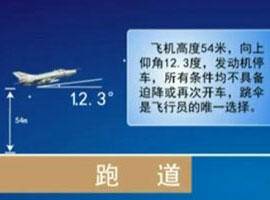



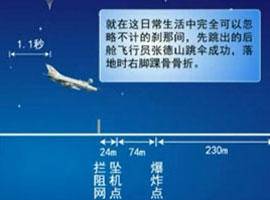
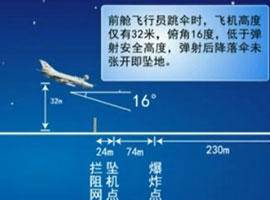
到飞行轨迹已避开居民区,按照飞机设计中后舱要先于前舱弹射的跳伞程序,无论谁打跳伞环,都是后舱先弹出。因后舱和前舱弹射按自动程序控制有1.1秒钟的延迟,先行跳出的后舱飞行员张德山跳伞成功,落地时右脚踝骨骨折。而前舱飞行员冯思广跳伞时,飞机高度仅有32米,且带有16度俯角,低于弹射安全包线高度,弹射后降落伞尚未张开即触地,壮烈牺牲。
大忠大爱的230米告白:
回放
据事后测量,飞机坠落后距前方居民区距离最近一块残骸,跟居民区仅230米。
剖析
“如果飞行员处置时哪怕有1秒钟的犹豫,飞机必将坠入拥有4000余名常住人口的居民区。”冯思广所在师
师长詹仁明说,“他们生死间的一次‘推杆’,将安全留给群众,危难留给自己,做出了不愧于党和人民的英勇抉择。”
冯思广烈士用生命捍卫的一片热土:

(来源:新华网 505096转载)
向济空飞行员冯思广致敬!向所有的“蓝天英雄”致敬!
冯思广:用生命铸就忠诚!
本文内容于 2010-5-22 8:08:13 被2033356编辑
赞
https://jnews.xhby.net/waparticles/234/u0G8eDnh8Nbug3JE/1
The martyr gave up the parachute sacrifice should not be harsh, the pilot knows better than us how to choose
2017-11-22 18:20 Meeting point
On the 7th of this month, Huang Peng, a pilot of the Yuxian County of Hunan Province and a pilot of the flight squadron, was attacked by an aircraft accident during flight training. In order to save the fighters, Huang Peng abandoned the best chance of escape and eventually died heroically, only 30 years old. After the accident, people sighed for the heroes and raised two old topics: whether they should protect the plane in the event of an accident or a strong parachute to protect the pilot, and who is more precious to the pilot and the plane.
(Huang Peng is driving the J-11B fighter) (Huang Peng is driving the J-11B fighter)
There is no doubt that the price and operating costs of modern fighters are extremely expensive. For example, our military trains the K-8 trainers commonly used by pilots, each of which is about 20 million yuan, and has a life expectancy of about 8,000-10,000 flight hours. In this way, only the oil money and aircraft depreciation expenses are calculated, and the flight cost per hour exceeds 10,000 yuan. According to media reports, the Chinese Air Force used 歼 -7 to train 100 students to spend about 2.45 billion yuan, so it takes an average of 25 million yuan to train a trainee.
(K-8 trainer) (K-8 trainer)
In the United States, the cost per flight hour of the F-22 Raptor is about $30,000. The same four-generation machine, the Hong Kong media "Ta Kung Pao" said that the hourly flight cost of the J-20 fighter is 300,000 yuan. This data does not know the authoritative basis, but it should be high or low, and it should be a lot higher.
(F-22 in the hangar, such four-generation machine is extremely expensive to operate, but still not as valuable as the pilot) (F-22 is in the hangar, such four-generation machine is extremely expensive to operate, but still not as good as the pilot valuable)
There is a reference here. The price announced by the Russian side for the purchase of the Su-35 fighter jet by our army is about 80 million US dollars, or about 500 million yuan, which is only the price of the body itself. Counting on-board equipment, supporting ammunition, etc., usually at least double the price. Calculated according to the life of the body 2000-4000 hours (not counting the medium-term life extension), plus expensive aviation fuel costs (plus at least 10 tons or more, the price exceeds 100,000 yuan), so that the cost per hour is close The Ta Kung Pao said 300,000 yuan. If you count the normal training and ground support, the flight cost of the 3.5-generation machine of the Su-35 is likely to increase. So obviously, the four-generation machine that needs a special machine shed will only cost more.
(At present, there are many Su-35s joining the Chinese Air Force) (currently many Su-35s have joined the Chinese Air Force)
But compared to the value of the pilot, the value of the aircraft is not necessarily expensive. For the cost of cultivating a pilot, there is a common saying that it is about the same weight as gold. What is the authenticity of this statement? Take our military as an example. At the beginning of the selection, the country will spend a lot of selection costs, and the flight can be said to be "one thousand miles." To become a flight student is just a start. To become a pilot who can take on the task of combat duty before Huang Peng, he has to undergo "three-level five-stage" training. The so-called "three levels" are college training, base training, and army training. The "five-stage" is basic training, initial education, high-education training, modified training, and tactical training. All the above trainings, from "flying seedlings" to a "novice" that can only fly three generations of machines, have been spent for five years, and the expenses are already very alarming. According to the statistics of the Air Force of China in 1986, it takes 2.87 million yuan to train a J-8 pilot who can take on the task of combat duty. The bomber-6 requires 4.65 million yuan, equivalent to 57 kg and 93 kg of gold, respectively. The weight is basically equal.
This is still only the second generation machine. It is widely believed that a mature three-generation aircraft pilot must have 1,000 hours of flight experience in the relevant model. As the flight captain of the third-generation aircraft, Huang Peng is certainly not low in flight hours. It is certainly not an exaggeration for the cost of training to exceed the weight of the pilot.
(歼-15 fighter with a forced landing) (歼-15 fighter with a forced landing)
The new data shows that the pilot's "worth" with gold is already yellow. Ma Dong, director of the Air Force's Nanjing International Selection Center, told the media that a qualified fighter pilot must reach 800 hours of flight training time, and the cost per hour is 400,000 yuan. Coupled with other expenses, training a fighter pilot requires at least 340 million yuan. In the recent news report that the 歼-15 carrier-based fighter plane crashed into the air and the pilot Cao Xianjian was driving and landing with fire, it can be known that the 歼-15, which is not high in output, is about 400 million yuan. Considering that the pilots of this type of fighter are currently selected from the "old bird" pilots (at least 5 aircraft, flying more than 1000 hours, three generations of fighters flying more than 500 hours), once sacrificed " The sunk cost will greatly exceed the value of the Flying Shark fighter. For example, the sacrifice of Zhang Chao’s martyrs is difficult to estimate.
(Zhang Chao Martyrs are on the 歼-15) (Zhang Chao Martyrs are on the 歼-15)
However, we have noticed that examples such as Huang Peng’s efforts to save the fighters are still in an endless stream. How should we understand this phenomenon?
For the test aircraft and the prototype, the aircraft that the pilot took back is definitely worthwhile. In this regard, our famous test pilot Li Zhonghua once said in CCTV that many times a plane is not just a matter of money. This is very reasonable, because the problem that caused the failure of the aircraft may exist on all the same fighters or other improved fighters in the same series. We have seen that after some military aircraft accidents, the military’s actions are often grounded. Model fighters, until the exclusion of hidden dangers, sometimes this stop is a few months. To save the fighters and discover hidden dangers, it is possible to save the comrades of the same type of fighters.
(Li Zhonghua said that he still has to do his best to save the fighters if he is not as good as the mountains and rivers.) (Li Zhonghua said that he still has to do his best to save the fighters if they don’t have enough water)
From the purpose of the test flight, if there is a fault, the skydiving, then many of the causes of the failure are difficult to explore on the wreckage of the aircraft. Even if there is a "black box" on the plane, there may be problems of data corruption and incomplete data recording. What's more, the pilot's subjective feeling is unmatched by any sensor.
Dropping the special model such as the prototype, for the production machine, it is certainly the value of the pilot is higher than the aircraft, there is no doubt. For ground commanders, it is also impossible to be unclear about the cost of training the pilot and the value of the aircraft. In the news report of Cao Xianjian, the ground commander said in an interview that if the plane is found to be uncontrollable, then he must be ordered to leave the plane. This shows that the ground does not require the pilot to leave the order to keep the fighter.
It is a professional instinct for the pilot to rescue the fighter and eventually bring it back to the fighter, or to make it controlled to crash and avoid injury to the ground personnel in an unsustainable situation. One argument is that a pilot who jumps directly on a plane cannot grow into a good pilot. His professional self-esteem does not allow him to abandon the plane as soon as he encounters problems - this is in general with the "human life is higher than Everything "of course has contradictions. Modern warplane accidents are fast, difficult to land, and technically demanding. For the public, it should be understood that pilots, as long-term professionals, must make more choices than sitting on a safe ground. They should respect them. s Choice.
(Aircraft ejection test, there are not many good ejection conditions in actual flight) (Aircraft ejection test, there are not many good ejection conditions in actual flight)
At the same time, it must be clear that pilots who sacrifice such "tuition fees" must pay, although sometimes it is too expensive. China has avoided many accidents because of its latecomer advantage, but there are still many obstacles that must be ruled out by human “violence”. This process is likely to be accompanied by sacrifice. For example, in the field of carrier aircraft, the most critical flight control system fault involving aircraft attitude control, because it is a combination of software and hardware, whether there is a BUG is not found in the machine room to debug, must also rely on the actual operation .
(Photo of the US Army "Forrest" aircraft carrier aircraft accident) (Photo of the US Army "Forrest" aircraft carrier aircraft accident)
Our army has already sacrificed more than 2,000 pilots, and it is expected that more sacrifices will occur on this road, which is inevitable. In the case of the US Navy, the absolute leader in the field of carrier aircraft, in 2008, 16 aircraft and 35 people were killed as a result of the accident. In the 1950s, when the jet carrier aircraft was just put into military applications, the number of US Navy carrier aircraft accidents was even more ridiculous: in 1953, there were 2,266 Class A flight accidents, 700 aircraft loss, and 423 outstanding pilots; 1954 In the year, 776 aircraft and 535 carrier-based pilots were lost. This scale has been put into the present, which is equivalent to the annual return of the US active carrier aircraft. And just as the author wrote this paragraph, the US "Reagan" aircraft carrier aircraft fleet C-2 "Greyhound" transport aircraft disappeared, adding the latest blood color footnote for this example.
(The test pilot Xu Yongling himself fell twice) (test pilot Xu Yongling himself fell twice)
To support the power of the great powers, the road is so full of thorns and danger. In 2005, a US retired pilot pointed out in his book that the US Air Force would drop an airplane every 10 days. In April last year, Zhang Chao’s sacrifice, other Chinese troops also had flight accidents. Xu Yongling, the chief test pilot of the J-10, pointed out after the disclosure of the death of Zhang Chao’s martyrs: “Flight risk is part of the flight, and its laws can be recognized and mastered. We can gradually reduce the flight with good training and scientific risk management. The accident rate, but the absolute "zero accident" is difficult to do. The accident is not terrible. What is important is that we can find out the regularity and experience from the technical interpretation of the accident."
Editor: Chen Yuefei
Http://bbs.tiexue.net/post_4262224_1.html
Iron network
Iron and Blood Military > Iron and Blood Military Forum > Air Force Forum > Pilots to avoid the plane crash in Jinan City, postponed parachuting heroic sacrifice (rolling update!)
Pilots sacrificed the parachute heroic sacrifice in order to avoid the plane crashing in Jinan City (rolling update!)
2033356 2010/5/20 14:55:46 480 71164
Guide: On the evening of May 6, a plane of a certain division of the Jinan Air Force suddenly stopped during the continuous take-off, and there was a danger of falling in the urban area of Jinan. In order to avoid causing major accidents, the two pilots tried their best to change the flight path, in which the pilot Feng Siguang sacrificed for missing the best time to parachute!
These are the photos of the air force pilot Feng Siguang’s martyr, to see how sunny and handsome the Jikong pilot Feng Siguang
Jagged website reminds you: Click to view larger image
Feng Siguang's photo at the flight school
For five years, the years have been dedicated to the country, and in the 28th year, Fenghua Zhengmao has dedicated himself to the people.
In the past few days, Quancheng Jinan has spread the heroic deeds of the Jikong pilot Feng Siguang to defend the lives and property of the people: On the evening of May 6, Feng Siguang and the squadron leader Zhang Deshan drove the engine to stop suddenly during the continuous takeoff, in order to avoid the plane falling. In the densely populated area of Jinan, Feng Siguang put his personal life and death out of the way, and together with Zhang Deshan decisively changed the flight path, but he sacrificed the best time to miss the skydiving. "He used a precious life of 28 years old to write a song of loyalty to the party and love the people!" Feng Siguang said that Zhan Renming, a division commander of the Jikong Air Force, said that on May 6, the division organized a cross-day flight in Jinan. At 20:51, pilots Feng Siguang and Zhang Deshan took off. At 21:30, the second landing continued to take off at a height of about 50 meters. The engine sound suddenly decreased and the thrust dropped rapidly. The rear cabin pilot Zhang Deshan hurriedly reported to the ground that "I stopped." The flight commander and division chief of staff, Shen Shufan, was decisive. Issue instructions: skydiving! parachute!
At the beginning of the millennium, Feng Siguang and Zhang Deshan are very clear: not far from the front and the bottom of the plane is a large residential area and night market. If you don't change the flight path, the consequences are unimaginable!
At the juncture of life and death, Feng Siguang and Zhang Deshan have only one idea: to maximize the protection of the lives and property of the people. They did not immediately abandon the aircraft to parachute, pushed the steering column forward in unison, and quickly pushed the aircraft from the elevation angle of 12.3 degrees to a depression angle of 9.8 degrees, and saw that the flight path had avoided the residential area before the parachuting was implemented. The flight ginseng record shows that before the pilot parachuted, the steering column was pushed 44 mm forward, thus changing the flight path.
According to the aircraft seat ejection procedure, the rear cabin is ejected before the front cabin at an interval of 1.1 seconds. Just between this 1.1 seconds, Zhang Deshan, the rear cabin pilot who jumped out first, successfully parachuted. When the front cabin pilot parachuted, the height of the aircraft was only 32 meters, and it had a 16 degree depression angle, which was lower than the height of the ejection safety envelope. After the ejection, the parachute did not open and fell, and the front cabin pilot Feng Siguang sacrificed heroically.
The "pushing rod" of the crew's choice of life and death changed the flight path of the aircraft, changed the life course of a young pilot, and protected the lives and property of the people. According to the survey, the distance between the plane and the residential area is 230 meters, and there are villages, hotels, factories, markets and logistics stations nearby. The resident population is about 4,000. If not two pilots are at risk





































































